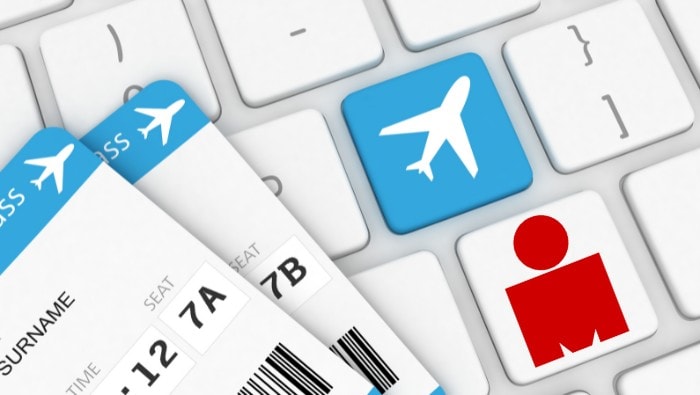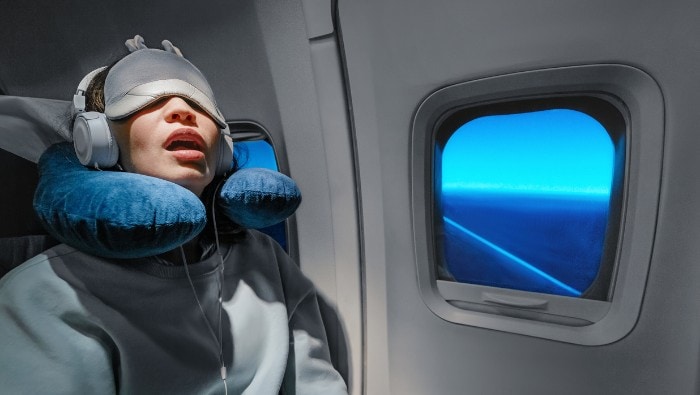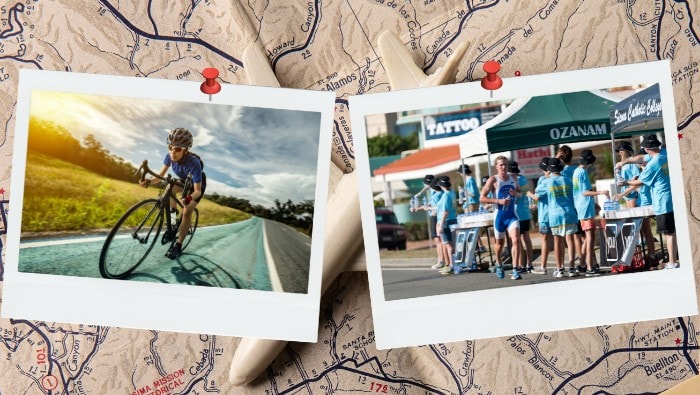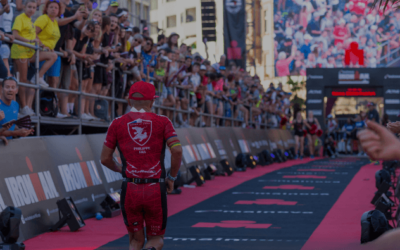Get ready to dive into a world of travel hacks designed to elevate your Ironman Triathlon travel experience to new heights. As you gear up for the ultimate test of endurance, we understand that smooth travel is a crucial component of your journey. That’s why we’ve embarked on a mission to gather the top travel hacks specifically tailored for Ironman triathlon participants like you.
Our team has made a thorough search to bring you a collection of hacks, tips, and tricks that will make your travel experience as smooth as possible. From packing your gear efficiently to navigating airports with ease and getting cheap flights, we’ve got you covered at every stage of your journey.
But we won’t stop there. We understand the importance of staying fueled and focused throughout your race. That’s why our travel hacks will also delve into nutrition tips, training on the go, and recovery strategies to ensure you’re in peak condition come race day.
With our expertly curated travel hacks, you’ll be well-equipped to conquer any obstacle that comes your way. Let’s dive in and prepare for the adventure of a lifetime!
Booking The Travel
Preparation is key to success, that’s why I’ve gathered valuable travel hacks to help you navigate the world of affordable flights while keeping the budget impact to a minimum.
Let’s explore creative ways to maximize airline miles, credit card rewards, and other strategies to find the best deals for your Ironman Triathlon journey.

Hacks for finding affordable flights to Ironman Events.
Start Early and Be Flexible:
To secure the best flight deals, it’s crucial to plan ahead and book your flights well in advance. By doing so, you increase your chances of snagging discounted fares.
Additionally, remaining flexible with your travel dates can open up a world of affordable options. Consider arriving a day or two earlier to explore the destination or departing a day later to unwind post-race.
Leverage Airline Miles and Credit Card Rewards:
If you’re a frequent flyer, capitalize on your accumulated airline miles and credit card rewards. Research airlines that offer partnerships or alliances with the Ironman Triathlon event locations. By booking your flights with these airlines, you can earn additional miles and rewards, which can be redeemed for future trips or upgrades.
Explore Travel Search Engines:
Travel search engines are your best friends when it comes to finding affordable flights. Here are a few top-notch platforms worth exploring:
- Skyscanner: This versatile platform allows you to compare prices across multiple airlines, set price alerts, and utilize their “Everywhere” feature to find the cheapest destinations based on your chosen dates.
- Kayak: Known for its comprehensive search capabilities, Kayak enables you to explore various options, including flexible dates and nearby airports, to uncover the best deals.
- Google Flights: With its intuitive interface and powerful search algorithms, Google Flights helps you find the most cost-effective flights. Utilize their flexible date feature and explore different departure airports to maximize your savings.
Stay Alert for Flash Sales and Special Offers:
Avid travelers know the thrill of discovering flash sales and special offers. Follow airlines and travel websites on social media, sign up for their newsletters, and set price alerts to stay informed about time-limited promotions. This way, you can seize fantastic deals as soon as they become available.
Travel in Groups:
If you’re participating in an Ironman Triathlon event as part of a group, consider booking flights together. Airlines often offer group discounts, which can significantly reduce your travel expenses. Reach out to event organizers or fellow athletes to explore potential group travel options.
Research Alternative Airports:
When planning your trip, explore nearby airports apart from the primary destination’s hub. Sometimes, flying into a secondary airport can result in more affordable flights. Plus cost and convenience of ground transportation to the event location when making your decision.
How to pack for Ironman Events and avoid checked baggage fees
Now that you have your cheap flight secured. It’s time to focus on packing efficiently to help you avoid extra baggage fees. Here are our travel hacks to help you pack more efficiently:
Pack Like a Pro
When it comes to packing for an Ironman Triathlon, it’s all about finding the right balance between essential gear and avoiding excess baggage. Here’s what you should prioritize:
- Race Gear: Begin by organizing your race essentials, including your triathlon suit, goggles, swim cap, bike shoes, helmet, running shoes, and other necessary apparel. Roll your clothes tightly to save space and prevent wrinkles.
- Necessities: Pack travel-sized toiletries, a first aid kit, sunscreen, and any prescribed medications. Consider investing in lightweight and compact travel gear such as microfiber towels, collapsible water bottles, and a portable foam roller for post-race recovery.
- Layering Options: Ironman events often feature various weather conditions, so pack a range of clothing options for different climates. Lightweight, moisture-wicking clothes are ideal for the race, and don’t forget to include a waterproof jacket and warm layers for post-race recovery.
- Snacks and Hydration: Carry energy bars, gels, or any preferred snacks to fuel your training and keep you energized during travel. Bring an empty reusable water bottle to fill up after security and stay hydrated throughout your journey.
Carry-On Strategy
Optimizing your carry-on bag is a crucial travel hack for athletes. By avoiding checked baggage, you’ll save time and money while ensuring your essentials are within reach. Follow these tips:
- Research Airline Policies: Different airlines have different carry-on size restrictions, so familiarize yourself with the guidelines before packing. Most allow a carry-on bag and a personal item, such as a backpack or laptop bag.
- Choose the Right Bag: Opt for a durable and spacious carry-on bag that fits within airline regulations. Look for compartments and pockets to keep your items organized. Backpacks with multiple compartments work well for athletes as they provide easy access to specific gear.
- Priority Packing: Pack your race gear, electronics, valuables, and essentials in your carry-on bag. This way, even if your checked luggage is delayed, you’ll still have everything you need to get started.
- Check Airport Amenities: Many airports now offer fitness centers, showers, or relaxation areas. If you have a long layover, research the amenities available to freshen up or squeeze in a quick workout before your next flight.
Minimize Checked Baggage Fees
Athletes often require specialized equipment, which may exceed standard baggage limits. Follow these tips to minimize checked baggage fees:
- Compare Airline Policies: Research airlines that offer generous baggage allowances for sports equipment. Some carriers waive fees for athletes traveling to sporting events, so take advantage of these policies.
- Equipment Rental: Consider renting bulky gear like bikes or wetsuits at your destination instead of transporting them. Research local rental options well in advance to ensure availability.
- Share Gear with Fellow Athletes: Connect with other participants through online forums or social media groups. Collaborate with athletes in the same event or nearby locations to share gear, reducing overall baggage weight and costs.
- Sponsorship and Shipping: If you have sponsors or team affiliations, inquire if they can assist with shipping your equipment. This could potentially save you from excessive baggage fees and logistical challenges.
Transportation
After you have arrived at your destination, the next big problem will be transportation and getting around a new city. Here are some hacks and tips that will help ease the transportation woes.

Renting a Car vs. Public Transportation:
When it comes to getting around during your Ironman Triathlon event, you have two primary options: renting a car or using public transportation. Let’s analyze the pros and cons of each:
Renting a Car:
Pros:
- Convenience and flexibility: Having a rental car gives you the freedom to explore the area at your own pace, conveniently travel to different race-related venues, and store your gear securely.
- Storage capacity: A car provides ample space to transport your bike, gear bags, nutrition supplies, and any additional equipment you may need.
- Time efficiency: Renting a car can potentially save time by eliminating the need to navigate public transport schedules and routes.
Cons:
- Cost: Renting a car can be expensive, especially when factoring in rental fees, insurance, fuel costs, and parking fees.
- Parking challenges: Depending on the event location, finding parking near race venues can be a challenge, and parking fees may add up.
- Navigation stress: Navigating unfamiliar roads and dealing with traffic can be stressful, particularly when you’re already focusing on race preparation.
Public Transportation:
Pros:
- Cost-effective: Public transportation is generally more budget-friendly than renting a car, especially in urban areas where event venues are easily accessible.
- Reduced stress: Letting someone else handle the driving allows you to relax and conserve energy before the race.
- Environmental impact: Opting for public transportation aligns with eco-friendly practices, reducing your carbon footprint.
Cons:
- Limited storage: Public transportation may have restrictions on the size of gear or equipment you can bring, potentially requiring additional logistical planning.
- Schedules and routes: Depending on the city and event location, public transport schedules may not align perfectly with your race-day needs, requiring careful planning and early departures.
- Crowded conditions: During peak hours, public transport can be crowded, making it challenging to manage your gear and maintain comfort.
Navigating Transportation in Unfamiliar Cities
Navigating unfamiliar cities can be a daunting task, but with these practical tips, you’ll be a transportation pro in no time:
- Research local transport options: Familiarize yourself with the local transport systems, including buses, trains, and subways. Check schedules, routes, and any race-specific transport services provided by the event organizers.
- Purchase transportation passes: Look into purchasing daily or weekly passes for public transportation. This can save you money and provide unlimited travel within a specific time frame.
- Utilize transportation apps: Download local transportation apps that provide real-time schedules, routes, and maps. These apps can be invaluable for navigating unfamiliar cities efficiently.
- Plan your routes in advance: Identify the locations of race venues, registration centers, and other key destinations. Plan your routes and transportation options accordingly to ensure you arrive on time.
Transporting Your Bike
Transporting your bike safely and efficiently is vital for a successful Ironman Triathlon. Consider the following tips:
- Bike case or bike box: Invest in a sturdy bike case or box to protect your bike during travel. These cases provide cushioning and security, minimizing the risk of damage.
- Disassemble and pack smartly: Remove pedals, wheels, and handlebars, and pack them securely in the bike case. Use bubble wrap or foam tubing to protect delicate parts.
- Know airline policies: Familiarize yourself with airline policies regarding bike transportation, including size restrictions, packing requirements, and additional fees. Call ahead to ensure you comply with their guidelines.
Controlling Jet lag
Traveling across time zones can wreak havoc on your body, making it crucial to have a smart plan in place to minimize the impact of jet lag. Let’s explore what causes jet lag and what sort of hacks can we use in order to minimize its impact on an Ironman athlete.

Understanding Jet lag
Jet Lag occurs when your body’s internal clock, or circadian rhythm, is disrupted due to rapid travel across different time zones. The primary cause of jet lag is the discrepancy between your body’s internal clock and the local time at your destination. This misalignment leads to a range of symptoms that can significantly impact athletes preparing for an intense event like the Ironman Triathlon.
So, how can you combat jet lag and arrive at your destination feeling refreshed and ready to conquer the race? Here are some scientifically proven methods to ease jet lag symptoms:
Adjust Your Sleep Schedule:
Start adjusting your sleep schedule a few days before your departure. Gradually shift your bedtime and waking time to align with the time zone of your destination. This approach helps your body adapt to the new schedule and reduces the shock of sudden time changes upon arrival.
Light Therapy:
Light exposure plays a crucial role in regulating our circadian rhythm. Expose yourself to bright natural light in the morning of your destination’s time zone to help reset your internal clock. If you’re traveling eastward, seek morning light, while evening light exposure is beneficial for westward travel.
Melatonin Supplements:
Melatonin, a hormone that regulates sleep-wake cycles, can be used as a supplement to aid in adjusting your body’s internal clock. Consult with a healthcare professional to determine the appropriate dosage and timing for your specific needs.
Hydration and Nutrition:
Staying hydrated is essential to combat jet lag. Drink plenty of water before, during, and after your flight. Avoid excessive caffeine and alcohol, as they can further dehydrate your body and disrupt your sleep patterns.
Nutrition
Proper nutrition plays a vital role in ensuring peak performance before, during, and after the event. Being in a constant travel state can present unique challenges for athletes aiming to maintain their nutrition routines. We have gathered a collection of nutrition on-the-go hacks to help you stay on top of your game.

Pack Snacks:
When traveling to an Ironman event, it’s crucial to have nourishing snacks readily available. Opt for portable options such as protein bars, nuts, and dried fruits. These snacks provide essential nutrients and are convenient for long journeys.
Hydration on the Move:
Staying hydrated is key, so carry an empty water bottle and fill it up after passing security checkpoints. Most airports and train stations have water fountains available. Aim to consume at least eight ounces of water every hour during travel.
Research Local Dining Options:
Before you arrive, research nearby restaurants or grocery stores that offer healthy meal choices. Scout for venues serving balanced meals rich in carbohydrates, lean proteins, and vegetables. Fueling your body with nutritious food will give you the energy needed for optimal performance.
Bring Supplements:
Consider bringing travel-sized portions of supplements like electrolyte powders, multivitamins, and omega-3 capsules. These can be easily packed in your carry-on luggage and help maintain your nutrient intake during the journey.
Now armed with a collection of travel hacks for Ironman Triathletes, you’re ready to conquer the world one race at a time. From smart packing to mindful nutrition, we’ve covered every aspect to make your journey easy going.
Remember, preparation is key, and these hacks will prepare you for what you need. Safe travels and may the road lead you to triumph!





0 Comments